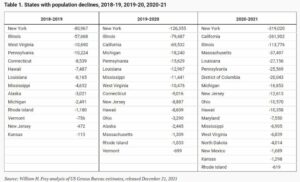After suffering through the first full year of the COVID-19 pandemic, many people in the United Areas moved from states such as California and New York, seeking sanctuary in places with cheaper taxes and less stringent public health regulations.
In a new report from the Census Bureau, it is revealed that the population of 18 states (plus Washington, D.C.) decreased between July 2020 and June 2021.

However, the losses suffered by most states pale in comparison to the migration from New York and California, which occurred in large numbers. During that 12-month period, the populations of the two states decreased by 319,000 and 260,000, respectively.
Illinois, which has been losing residents for several years, came in third place after losing approximately 113,000 people in the last year.
However, when viewed as a percentage of their overall population, no city suffered as severely as Washington, D.C., which lost more than 3.4 percent of its pre-pandemic population in just 12 months, the most of any city affected.
Texas, on the other hand, added over 310,000 residents during the same time period, with Florida (211,000), Arizona (98,000), and North Carolina (93,000) also seeing significant in-migration during the same period.
Must read: Another January 6 Like Attack Can Happen Again If Trump Loses in 2024
In general, fewer people have relocated during the epidemic than they would have done in a usual year. Separate data from the Census Bureau released a few months earlier showed that the number of people who moved fell to its lowest level in at least 70 years over the 12-month period between April 2020 and March 2021.

Nonetheless, this simply serves to bring some of the migratory statistics into even sharper focus. Despite the fact that there were fewer moves overall, both New York and California had a considerable increase in the number of persons who left over the period July 2020 to June 2021.
The epidemic, as it did in other ways, appears to have intensified movement patterns that were already in motion at the time.
As William H. Frey, a senior scholar at the Brookings Institution points out, “California and New York suffered significantly bigger population losses in 2020-21 than they had in the previous two years, as was the case for other states that had suffered recent population declines.”
After decades of spectacular growth, New York has been losing population for years, and California’s population has been practically stable for the past decade, after decades of tremendous increase.
The state of California will see its congressional delegation decrease for the first time in history as the rest of the country grows more quickly.
There are numerous reasons why someone can decide to relocate from one location to another, and those decisions are likely to be influenced more by personal circumstances than by broader political or economic difficulties.
Therefore, we should be cautious about putting too much emphasis on migration statistics. People on both sides of the political spectrum may attempt to score political points by asserting, for example, that Americans are relocating from blue to red states.
And, in broad strokes, it’s possible that this is true. However, it fails to recognize the more nuanced reality that people make personal decisions for a variety of reasons, many of which are not political in nature.
States are not monoliths—someone relocating to the growing West Texas city of Midland is likely doing so for a different reason than someone relocating to the equally booming Austin—and a successful state is capable of drawing people from a variety of diverse backgrounds and lifestyles.
Successive states, on the other hand, grow in spite of rather than as a result of their national political stereotypes.
It’s difficult to look at the latest Census Bureau data without drawing some broad conclusions about what it was about California and New York (and, to a lesser extent, Washington, D.C.) that made them such extraordinary outliers over the past year.
Pandemic preparedness policies spring to mind immediately. Businesses in New York were not allowed to expand their capacity until May of this year, more than a year after similar limitations were eliminated in the majority of other cities.
Small enterprises were hit the most by the city’s economic regulations, which were frequently arbitrary and made little sense. Parents and children suffered as a result of school closures, which were concentrated in big cities and blue states – areas that have, unsurprisingly, had a proportional decline in enrollment as a result of the closures.
People frequently cite “financial pressure” as the primary cause for their relocation, and policies enacted during the pandemic era have been ripe for causing fresh financial troubles for a broad swath of the population.
Nonetheless, I believe that something more is being revealed in the Census statistics, something that goes beyond dissatisfaction with pandemic regulations and school closures.
Wendell Cox, a demographics and policy specialist who operates a consulting firm in St. Louis, points out that the district’s population loss of approximately 3.3 percent comes after a time in which the district experienced strong year-over-year population growth for the previous decade.
After that, he examines the states that are seeing population growth—and not just the largest ones.
According to Cox’s article in New Geography, a blog about urban policy and demographics, “West Virginia saw its net domestic migration total increase to 2,300 from its previous decade average of minus 4,600.”
“West Virginia, well within the range of a remote worker spending only a few days per month on-site, saw its net domestic migration total increase to 2,300 from its previous decade average of minus 4,600,” she writes.
“Delaware, which is also close to Washington, as well as Philadelphia, which has the nation’s sixth-largest downtown, saw its net domestic migration gain increase to 12,000 from its previous decade average of plus 5,000,” according to the report.
West Virginia and Delaware have certain characteristics in common with other rapidly growing states such as Texas, Florida, and Arizona, including low taxes and relatively inexpensive land for development (with some exceptions, of course).
Whereas remote work (or part-time remote work) is likely to become more prevalent in the future, places like West Virginia and Delaware stand to benefit greatly from the post-pandemic sorting out that will take place along the East Coast, where the geography of having a large number of states clustered close together encourages more robust competition.
It is possible that more people will choose to avoid paying the high cost of living and high taxes associated with living in New York City, Washington, D.C., or its surrounding suburbs if they only have to go into the office once per week.
Also check: US Reports Lowest Population Growth Rate in Decades
Of course, the vast majority of people will remain. In spite of the fact that it lost an astonishing percentage of its population in a single year, 96% of Washingtonians are still residents of the state.
New York City will continue to be one of the world’s most important economic engines, and California will continue to be a state with virtually limitless natural resources.
However, the number of Americans who relocated during the pandemic should serve as a warning to policymakers about what is happening on the periphery of society.
While there is genuine competition between states in this area, the eventual lifting of pandemic limitations would not immediately reverse the trends that COVID has put into high gear.
It’s inevitable that certain states will not approve of where people choose to live in a world where more employees have the freedom to live where they want.

